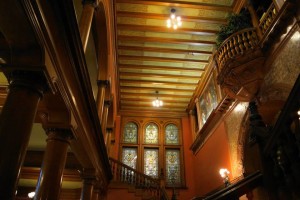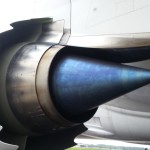Greetings All,
Since I last wrote, I was very fortunate to visit a town in Florida that is near Daytona Beach. Two weekends ago, my friends and I drove a little less than an hour north to St. Augustine. The minute I saw this town, I absolutely loved it. According to the City of St. Augustine’s website, this town was founded in 1565 by the Spanish, which makes it the oldest continuously occupied settlement in the United States. For those of you who are history buffs, this means that St. Augustine is 42 years older than Jamestown and 55 years before the Pilgrims landed at Plymouth Rock.
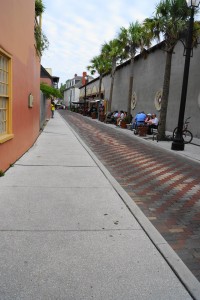
This is one of the side streets of St. Augustine. As you can see, it was in the historic part of town. Taken by Courtney Hough, my roommate.
In the present day, this city thrives on tourism. There are plenty of locally owned shops carrying artwork created by people who live in St. Augustine. There are unique foods to try from family-run cafes to high-end restaurants. In the evenings, many places have live music from all over the world. St. Augustine is a truly wonderful place.
Even though this city is almost 450 years old, it has aged beautifully. In the older parts of the city, there are historic cobblestone streets and houses with balconies.
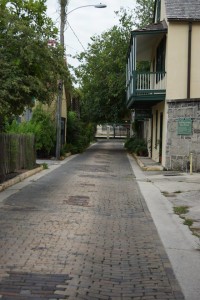
Many houses in the older neighborhoods looked like this one. I love houses with balconies. Taken by Courtney Hough.
In the Historic Colonial District, there are 36 colonial buildings that are still standing.
One of the most beautiful buildings is part of Flagler College.
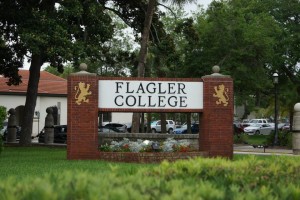
This is the sign in front of the college’s main buildings. Their school crest is amazing. Taken by Courtney Hough.
The main building was built in 1888 as part of the Spanish Renaissance architecture and was originally used for the Hotel Ponce de Leon.
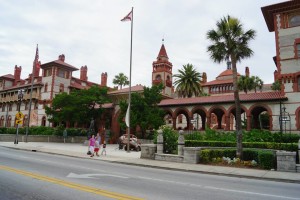
This is one of Flagler College’s main buildings which was originally the Hotel Ponce de Leon. Taken by Courtney Hough.
It was one of the first poured-in-place concrete buildings in the United States and one of the first electrified buildings. The inside is absolutely beautiful.
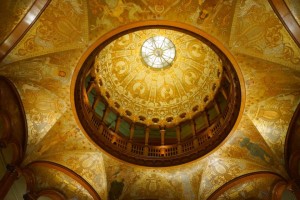
The inside of this building was incredibly gorgeous with dark polished wood and vibrant paintings and art. Taken by Courtney Hough.
The main entrance opens up into a courtyard with a fountain in the center and walkways leading to various parts of the buildings. In addition, there are many wonderful stained glass windows, mosaics, and murals.
Seeing all of the beautiful architecture of Flagler College makes me glad to be close enough to visit. For me, it is nice to see buildings, streets, and cities that were built hundreds of years ago because it gives me an appreciation for the hard work and dedication used in those times. Sometimes I feel that society is too busy dealing with the now or looking towards the future that the past is forgotten. While I enjoy modern cities of the United States, I sometimes feel that society has forgotten what it is like to plan not just for now, but for future generations. I believe that it is better to build and structure that is meant to last hundreds of years than to build one that may be torn down in maybe 15 years. It would save a lot of time and money in the long run, quality over quantity. It is interesting that the other big event of the past two weeks presents a strong contrast to St. Augustine and deals solely with the future and science.
Last Monday, Boeing’s new Dreamliner the experimental 787 was open to Embry-Riddle students for tours.

This is the tail section of the new experiments 787. Pictures were not allowed inside the aircraft. Taken in June of 2013.
Since the Dreamliner is still in the experimental stage, the side of this plane was essentially used as a flying laboratory. There were stations for each scientist and engineer that monitored the sensors mounted in and on the aircraft. Data gathered each day is then uploaded into a main computer for analysis. Probably one of the most intriguing aspects about the inside of the plane was the large water tanks located all over. When we asked some of the scientists, we found out that they use these water tanks to manipulate the center of gravity of the plane to simulate the plane being as full capacity with strangers and luggage. The system is brilliant because it is so simple.
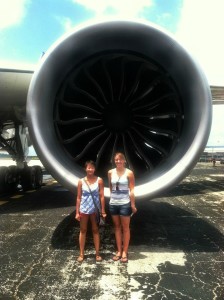
This picture shows of my roommate, Courtney, and I in comparison to the jet engines. Taken in June of 2013.
Well, that’s most of the exciting news of the past two weeks. The next entry should be from France. Fingers crossed for luck. Thank you for reading.
-Brenna


